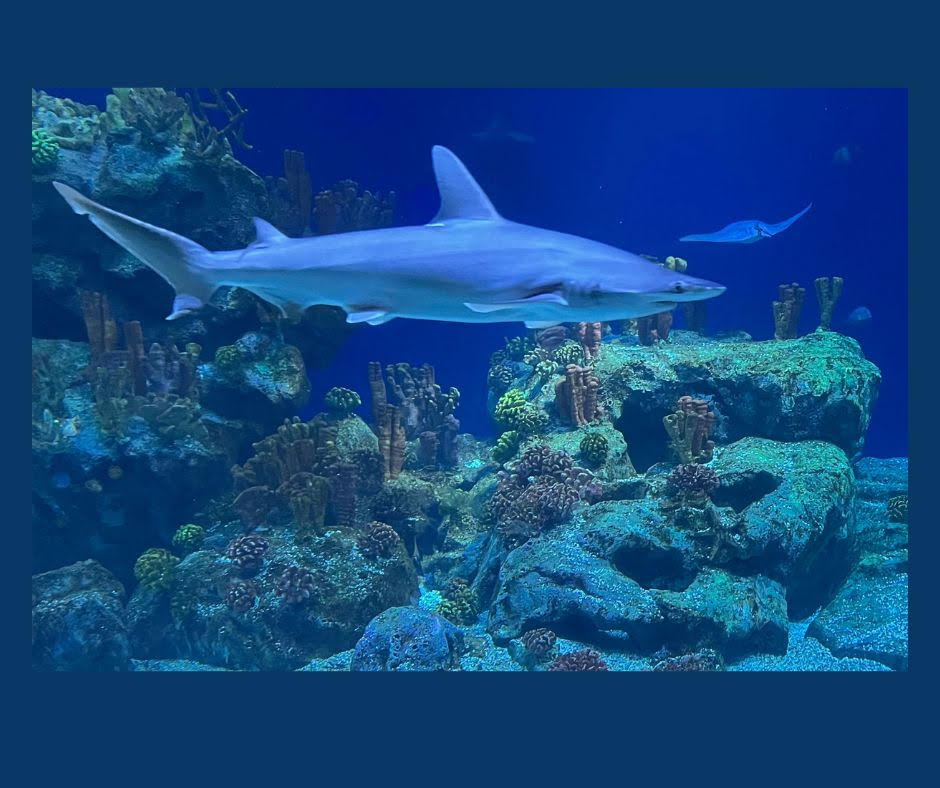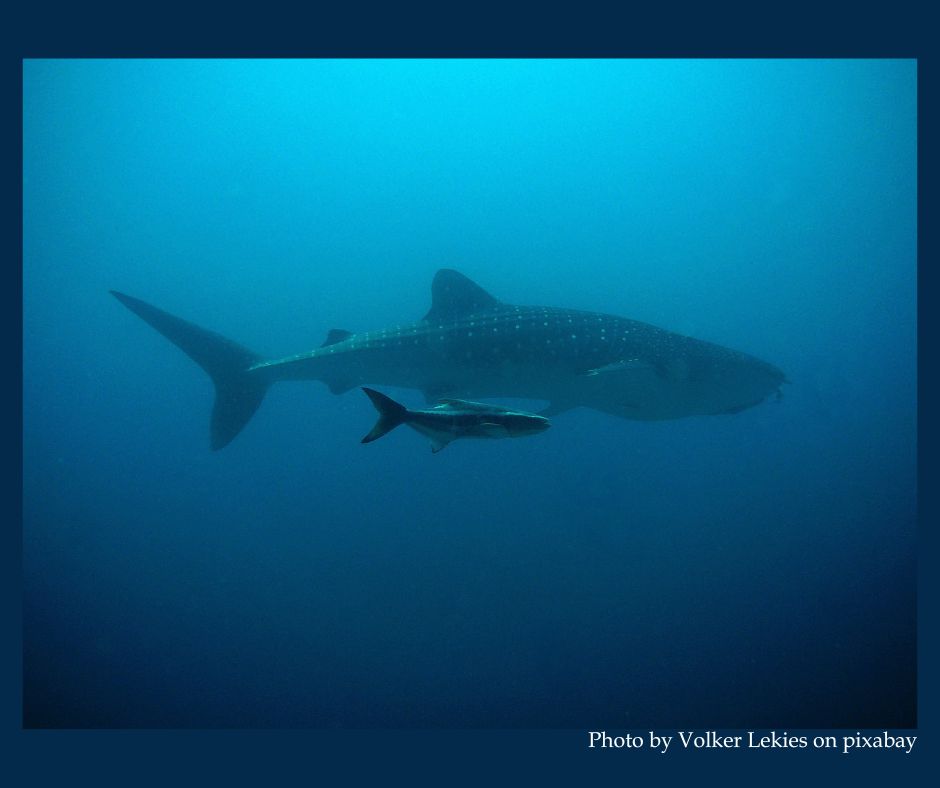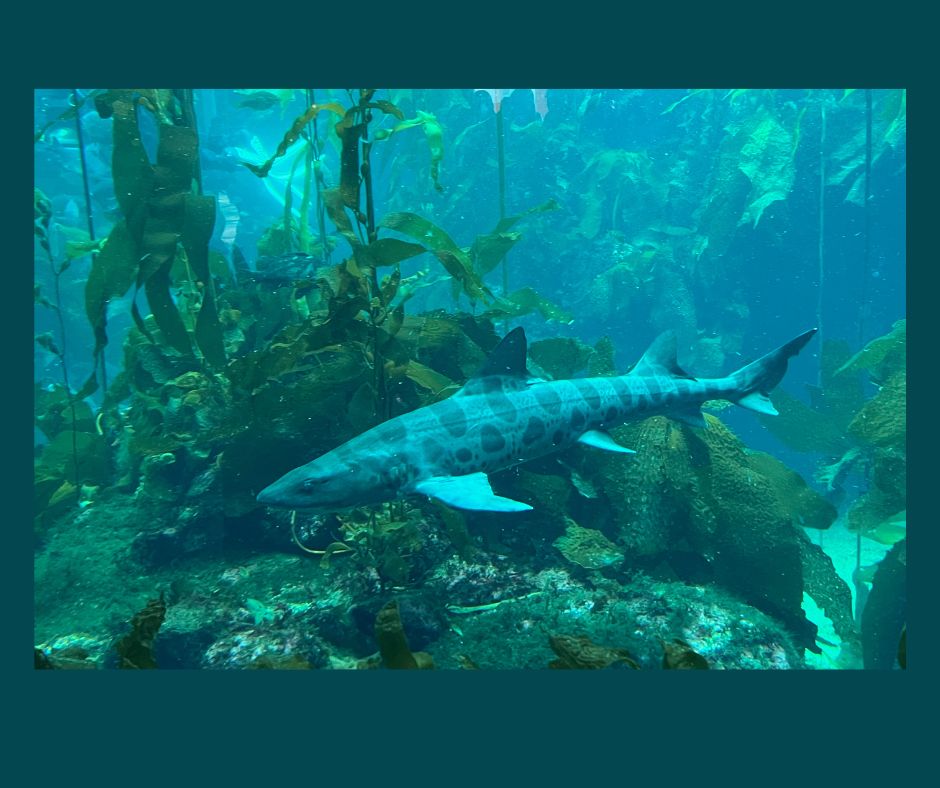Celebrating Sharks
by Susie Hairston

Ever since the movie Jaws came out, a large portion of the American public has viewed sharks in a negative light — as scary killers rather than the keystone species critical to the health of ocean ecosystems and thus fisheries humans rely on for food and jobs that they actually are. We have been taught to look at sharks in a simplistic way, when, in reality, sharks are complex, fascinating beings with a lot of diversity in their over 500 species.
The reality about sharks and attacks on humans
Mark Fisher, director of Texas Parks and Wildlife Department’s (TPWD) Coastal Fisheries Division pointed out in a 2024 Houston Chronicle article that bites are very rare with only a handful of shark bites being reported in the last 60 years. “Sharks do not regard us as prey, but people can be bitten, sometimes while wading or swimming among a school of fish that sharks are feeding upon,” he said. “Sometimes, we just get in the way.” And when sharks do bite a human, they usually bite a leg or an arm and let go. https://www.chron.com/gulf-coast/article/shark-attack-texas-beach-gulf-19472047.php
Sharks, who were present on the earth millions of years before humans, did not evolve with humans as part of their diet, and as a result, shark attacks on humans are rare.https://oceanservice.noaa.gov/facts/sharkseat.html
Fewer than 10 people worldwide are killed each year by shark attacks. To put this in perspective, over 40,000 people die in car accidents in the US each year and approximately 4000 die from unintentional drowning.
In 2024, sharks caused the death of 7 humans worldwide; in the US in 2024, 28 shark attacks occurred, and one death was caused by a shark.
Compare those numbers to the estimated 100 million sharks killed by humans each year, and you will understand which animal is the real threat to the other.
Without sharks the ocean food web would fall apart.
Sharks are a keystone species, meaning they are necessary for the survival of the ecosystem in which they live. They are apex predators who keep their ecosystem balanced, killing and eating the sick and weak animals in other species; by doing so, they both help keep the gene pools of those species strong and keep the entire ecosystem in balance so that, for example, the animals that eat the seagrass don’t overpopulate, killing off all the seagrass, which would then result in the death of other animals who rely on the seagrass for survival and so on, setting off a chain reaction that would lead to the destruction of the whole web of life.
Sharks are the systems managers who keep everything running smoothly.
Shark facts relevant to most sharks:
- scientific research suggests that sharks appeared in the ocean around 455 million years ago
- there are more than 500 species of shark
- their skeletons are made of cartilage, not bones
- they have multiple gill slits on the sides of their heads
- they can regrow their teeth infinitely
- they have good eyesight and great night vision
- they have special sensors that allow them to detect electromagnetic fields and temperature changes in the ocean
- like other fish, sharks have scales, but the tiny size, tooth shape, and direction of their scales make their skin feel like sandpaper
- many species of shark migrate to find food, to accommodate seasonal changes in ocean temperature, and to give birth
- most sharks live for 20-30 years;.Greenland sharks can live for 250 years

Even though sharks have a lot in common with each other and generally are critical for the survival of their ecosystems, they are not monolithic.
There is a lot of diversity within shark species
- Some sharks aren’t solely carnivores. Whale sharks, for example, eat mainly plankton; and the bonnethead shark is also an omnivore, eating both seagrass and fish
- some, like leopard sharks, are shy, and some, like oceanic white-tipped sharks are aggressive
- some, like the great hammerhead shark, are loners; others, like regular hammerheads, who can form groups of up to 500, like to travel with others
- some, like the dwarf lanternshark, who are between 6.3 and 7.9 inches long, are tiny, and others like the whale shark, the largest living fish with a length of between 18 and 33 feet, are huge
- some have distinctive appearances like the hammerhead shark and the sawshark whose nose is lined with teeth that he uses to slash at his prey with
- some, such as wobbegongs lie camouflaged on the seafloor waiting for prey to come to them and then pounce; others like spinner sharks swim in fast pursuit then leap out of the water and spin as many as three revolutions before diving back in to catch their prey, and thresher sharks use their huge tails to stun or kill their dinner.
Texas sharks
According to the Texas Parks and Wildlife Department, there are about 20 species of sharks that live in Texas coastal waters. Among the most common sharks found off the coast of Texas are bull sharks, blacktip sharks, spinner sharks, bonnetheads and Atlantic sharpnose sharks.
Bull sharks
- named for their stout bodies and aggressive nature
- can be 11 feet or more long
- are the only shark that can live in freshwater and saltwater
- has been known to go inland up freshwater rivers for hundreds of miles
Atlantic blacktip shark
- can grow up to 6 feet long
- found around beaches, bays, estuaries, and river mouths
- is confused with the spinner shark because it also leaps out of the water when hunting, but not as dramatically
- are known to only hang out with their own gender when they are not in mating season
- is a poster child for the importance of fisheries management. In 1998 they were so over fished that restrictions were put on commercial fisheries to protect them. Now their populations have grown so much that they can support four times the original harvest.
Spinner shark
- got its name from the fact that it “swims rapidly upward through a school of fish, snapping its body at them before leaping and spinning up to three times out of the water when it attacks!”
- is an average of 6 feet long
- is highly migratory
- has its meat and fins sold for human food and its skin for leather
Hammerhead sharks ( several kinds: including the great hammerhead, scalloped hammerhead, and bonnethead are found in the Gulf)
- has eyes on either side of its “hammer”
- eats stingrays, groupers and catfish on the ocean floor.
- Great Hammerheads
- can be up to 25-20 feet in length
- tend to be loners
- are critically endangered because their large size and prized fins make them heavily fished, and their long reproductive time doesn’t allow them to repopulate at the rate they’re being killed
- Bonnetheads
- nicknamed “shovel-heads,”
- are the smallest of the hammerheads, reaching only about 4 feet in length
- eat small invertebrates and fishes, specifically favoring blue crabs.
- are the only species of sharks to have a difference in characteristic(s) between males and females of the same species
- are considered quite shy and harmless to humans
- hang out in groups of about 15.
Atlantic sharp nose
- has a slender gray/brown body covered with white spots and a pointed nose
- is 2.5 -3 feet long
- feeds on multiple prey items including bony fishes, shrimp, and mollusks
- is preyed upon by large carnivorous predators including other sharks.
- is heavily fished commercially for its meat and also faces the threat of bycatch

We need sharks and sharks need our help
- More than 1/3 of shark species are endangered and are threatened with extinction as of 2025.
- Populations of sharks in the open ocean declined by 71% between 1970 and 2020.”
- much of the decline is caused by demand for shark meat and fins
- some
- is from bycatch, when sharks are caught and killed in nets intended to catch some other type of fish
- is caused by habitat destruction due to development along coastlines and pollution
- is caused by vessel strikes
What you can do:
- Spread the word about the irreplaceable and critical role sharks play in maintaining our ocean ecosystems that we all love and rely on.
- Support organizations like the World Wildlife Fund to help protect sharks, specifically targeting your donation to the shark program
- Support local environmental organizations and government organizations such as Christmas Bay Foundation Galveston Bay Foundation, Galveston Bay Estuaries Program, and Flower Garden Banks National Marine Sanctuary that conserve and support the health of coastal waters that sharks and other animals rely on to survive.
- Support organizations such as the Ocean Conservancy, which focuses on protecting the health of our oceans through a variety of methods
- If you eat fish, make sure that you are eating only shark friendly fish that were caught using methods that prevent bycatch. The Monterey Bay Aquarium has a web page that helps you find fish that are shark safe.https://www.seafoodwatch.org/seafood-basics/sustainable-healthy-fish
- Additionally, make sure you only buy fish and seafood with the MSC (Marine Stewardship Council ) label.https://www.msc.org/about-the-msc/what-is-the-msc
References:
https://www.amnh.org/explore/news-blogs/sharks-rays-myths
https://www.chron.com/gulf-coast/article/shark-attack-texas-beach-gulf-19472047.php
https://www.chron.com/life/wildlife/article/Texas-sharks-most-common-Gulf-of-Mexico-16316573.php
https://environmentamerica.org/texas/center/articles/shark-in-the-gulf-of-mexico
https://www.facebook.com/watch/?v=580520678253562
https://www.floridamuseum.ufl.edu/discover-fish/species-profiles/bull-shark
https://www.floridamuseum.ufl.edu/shark-attacks/yearly-worldwide-summary
https://www.ifaw.org/international/journal/faq-about-sharks
https://www.msc.org/about-the-msc/what-is-the-msc
https://oceanservice.noaa.gov/facts/sharkseat.html
https://www.seafoodwatch.org/seafood-basics/sustainable-healthy-fish
https://www.transportation.gov/NRSS/SafetyProblem
https://en.wikipedia.org/wiki/Whale_shark#Distribution_and_habitat
https://www.worldwildlife.org/species/shark
https://www.worldwildlife.org/stories/sharks-are-key-to-the-health-of-our-oceans-and-climate